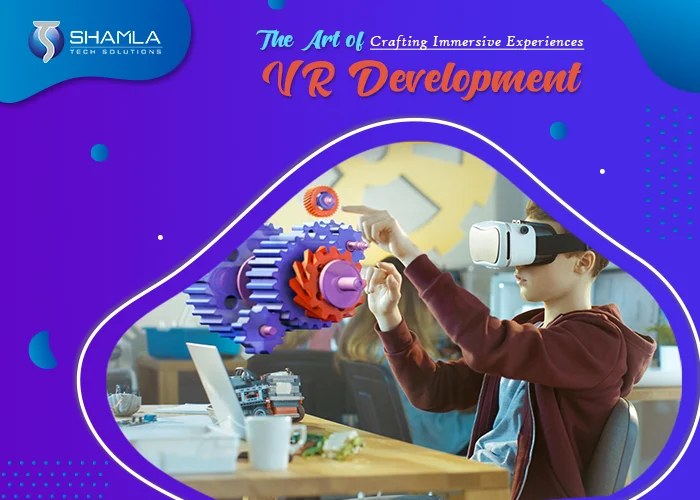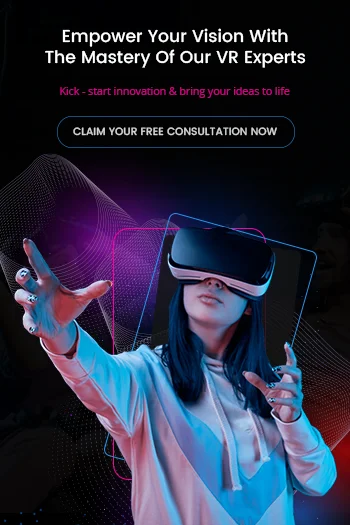The technological frontiers of virtual reality and augmented reality are transforming our interaction with digital settings. An in-depth introduction to VR/AR development is provided in this article for people who are new to these innovative domains.
Virtual and augmented reality are examples of technological wonders that create immersive experiences that surpass reality by fusing the real and digital worlds. While VR immerses consumers in a fully digital experience, AR adds digital elements to the user’s real environment.
These developments are not exclusive to the video game industry. They have established themselves in the training, retail, healthcare, and education sectors, among others, demonstrating their capacity to completely transform entire industries.
For example, VR can imitate intricate surgeries for surgeons, and AR may provide personnel servicing machinery with real-time data, enhancing efficiency and minimizing errors.
But the value of AR and VR extends beyond these practical applications. They represent a fundamental change in the way we will utilize technology moving forward. The market for virtual reality and augmented reality is expected to reach $161.1 billion by 2025, according to a report conducted by Global Market Insights. This indicates an unquestionable trend towards the eventuality of a seamless merging of digital and real-world experiences.
How to get started with VR development?
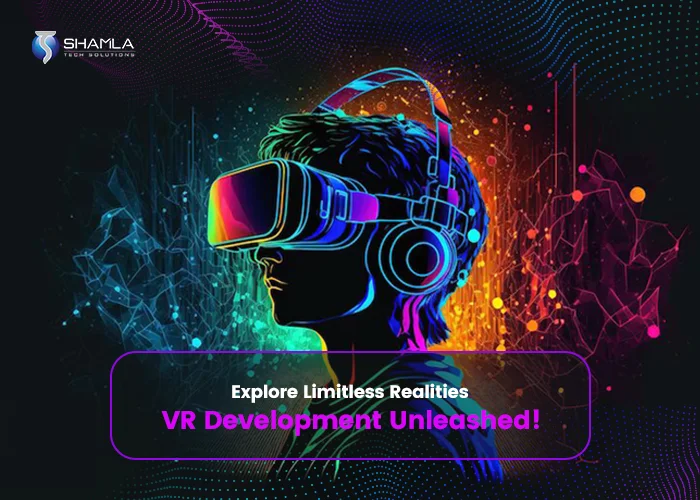
In virtual reality, one can engage with an artificial setting. Most users make use of an HMD, or virtual reality headset. The technique of building virtual worlds is called virtual reality development, and it calls both a specific skill set and a great deal of patience. Video games, movies, television, and entertainment all benefit from these abilities. VR has many more applications, including in business, education, and healthcare. There are several approaches to begin honing your virtual reality development talents.
- Choose the right development platform: The VR/AR business is dominated by Unity and Unreal Engine, two powerful development platforms. Your choice of platform will have a big impact on your VR/AR development journey. Every platform offers unique benefits and drawbacks.
Unity has gained appeal because of its versatility and ease of use. The fact that it supports over 25 platforms, including all major VR/AR systems, ensures broad accessibility. Unity’s primary benefit is its ease of use and simplicity, which makes it a fantastic choice for beginners. C# is the scripting language used for it, and learning it is made easier by its straightforward syntax.
But unity is not without its shortcomings. Even with improvements in graphical capabilities, it still generally falls short of Unreal’s excellent visual quality. Moreover, Unity sometimes struggles to fulfil the performance requirements of high-end VR applications.
Unreal Engine excels in graphics performance. It uses state-of-the-art particle and lighting technology to produce incredibly lifelike VR/AR experiences. Though it mostly uses C++, a more complex language than C#, Unreal has Blueprints, a visual programming system that can be simpler for novices to use.
One disadvantage of Unreal Engine is its steep learning curve, particularly for people who are not experienced programmers. Furthermore, while it does support a large number of platforms, its broad platform compatibility is not as extensive as Unity’s.
You have to choose between Unity and Unreal Engine based on your personal preferences and the requirements of your project. Some points to consider are as follows:
1.Visual Quality: If your project calls for complex graphics and realistic photos, Unreal Engine is the best option.
2.Learning curve: Novices with little to no programming experience may find Unity more suitable because of its user-friendly UI and simpler C# language.
3. Platform Support: Verify that the platform you select will work with the VR system that you are developing.
- Building a strong foundation: Playing games or using applications is a good way to get started with virtual reality. Students might also research successful virtual reality development initiatives. Students can become proficient in product design, video game design, 3D modeling, animation, and design theory through hands-on training. Programming requires knowledge of C#.
In other words, learning about the technology that underpins virtual reality is crucial for developing virtual reality applications. The virtual reality classes offered by NYFA are a great approach for students to learn about technology. Students can learn how to tell engaging virtual stories in this rapidly developing field by studying VR at a film school.
- Make the best use of free resources: Virtual reality training is included with Unity, and virtual reality courses are widely available online. When the prototype is complete, incorporate the right music and artwork to maximize immersion. Understanding the operation of the gyro and accelerometer sensors, as well as image processing and speech recognition, is also beneficial for mobile phones.
- Stay up-to-date with any new VR developments: The field of virtual reality is always changing, and students can gain more experience by experimenting more. It’s critical to keep up with industry developments if you want to pursue creative aspirations in virtual reality.
Best programming languages for VR development
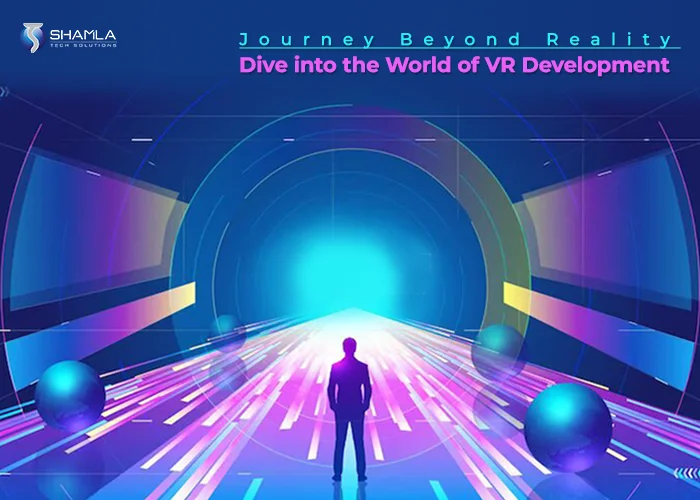
The use of virtual reality (VR) technology in a variety of media and experiences has been steadily increasing. It was mostly utilised as an attraction in large-scale amusement parks or in labs and patient rehabilitation centers for medical and research facilities until recently. These days, as VR headset technology advances, the market is starting to gradually spread to average homes.
As more people look for VR development resources, new libraries and technologies have (and will) inevitably emerged. Several businesses that have started focusing on VR technology now consider hiring VR programming personnel to be essential.
1.C#: Because of Unity, C# is one of the most popular languages for VR development. Over the past few years, Unity has gradually evolved from its original function as a framework for game production to an all-purpose tool for creating media. It provides all the resources needed to create a variety of VR experiences in a single package.
In addition, Unity provides a wealth of tutorials and code examples for creating VR experiences. By utilizing its sizable network, one may readily rectify any educational gaps left by Unity. Unity is not the only thing that keeps C# alive in the VR realm. For instance, you can use the C# package StereoKit to create VR applications in your current project.
Combined with the robust frameworks provided by.NET, creating VR experiences is much simpler. C# is a fantastic choice if you’re seeking for a language with strong libraries and frameworks for developing VR applications.
2.C++: The largest console and Windows games are made with this high-level programming language. This language offers a great deal of scalability and can be utilised for both small and large gaming projects, in contrast to certain other VR programming languages. Furthermore, it is platform-agnostic, meaning you may transfer projects with ease between other operating systems. Without a doubt, one of the greatest choices for employment with the Metaverse is the VR programming language. C++ is used in the development of video games like Player Unknown’s Battlegrounds, Fortnite, Elder Scrolls V: Skyrim, Dark Souls, and more. In conclusion, it is among the top 10 programming languages for virtual reality applications.
3.JAVA: This 1995-born language is regarded as one of the greatest object-oriented programming languages for general computer programming. The language was introduced with the goal of having fewer dependencies, especially when compared to other VR coding languages available at the time and even now. This is among the greatest ways for game creators to make games for the metaverse and any platform.
That this VR programming language was listed as one of the most widely used languages for game projects in 2021 is therefore not surprising. Among the video game projects created with Java are Mission Impossible III, Minecraft, and Ferrari GT: World Track.
4.JavaScript: The internet’s rise as a medium for content delivery coincided with a surge in the usage of web development languages.
JavaScript is now practically used for everything on the internet, including apps and web pages. These online experiences have given rise to VR applications, and numerous libraries have emerged to support developers working on the platform. And JavaScript is used to write the majority of these.
A JavaScript 3D library called three.js enables programmers to create virtual reality experiences. A-Frame was created on top of Three.js a few years later, with the purpose of creating VR solutions. It offered an Entity Component System framework. Other VR libraries for JavaScript include ViroReact, a React Native library that enables developers to easily prototype and create Virtual Reality experiences, and Babylon.js, a web rendering engine with tools for creating VR applications.
JavaScript is essential if you want to create VR web apps. It will help your ideas become a reality.
5.Python: When getting into VR, most people don’t think about learning Python. Still, it’s used by a few libraries and frameworks. Probably the largest and most excellent example is Vizard. It is a platform for developing VR apps for software development that runs on Python. Along with NASA, a large number of academic institutions and research centers employ it.
Aside from that, Python is a popular programming language for VR applications. One example is VRED, Autodesk’s 3D automobile prototype tool, which enables designers to utilize and test their designs in a virtual reality environment. Although the Python VR community is not as large as some of the others on our list, it still has a purpose.
6.Lua: All it is is a cross-platform, lightweight language that is gaining traction in the game industry. Lua’s simple syntax has made it one of the most popular programming languages for virtual reality. Game developers also primarily use this option for components like CryEngine, Gideros mobile, and Corona SDK. Among the most well-known VR programming language projects include Aquaria, Age of Conan, American Girl, and Angry Birds.
7.CSS3: The style sheet language known as CSS3, or Cascading Style Sheets, is used to render documents authored in markup VR coding languages like HTML. The language can extend the control over how a website is presented; it is the next generation of cascading stylesheets. Like JavaScript and HTML, this option is also a fundamental technology of the World Wide Web. In actuality, CSS3 and HTML5 make a lot of sense because they cooperate to produce the final rendered page. While CSS is in charge of style, Java Script is one of the computer languages used in virtual reality and is responsible for templating and dynamic elements.
8.CUDA-C: The top programming language for virtual reality, according to desktop game developers, is this one. With the help of this option, your game appears more realistic by utilizing high-definition graphics that create a convincing 3D image. Additionally, this language is among the best for creating virtual reality because it will bring greater lighting and colour to your game, making it more lifelike.
9.Swift: For projects involving games, this one is perfect. The majority of developers are captivated by Swift and can’t wait to utilize the new features to create their greatest games. You will quickly become proficient at animating textures and sprites with the aid of SpriteKit. Along the road, you will become an expert in physics, collision effects, animations, and game user interface creation. For this reason, a lot of developers favor utilizing this virtual reality programming language in their works.
10.HTML: Experts in gaming claim that this is a popular platform for developing cross-browser and cross-platform apps and games. Additionally, JavaScript and HTML can be used interchangeably. This option is popular among game creators since it is an easy-to-learn Virtual Reality programming language that does not require a deep understanding of algorithms in programming.
Best VR development tools for beginners
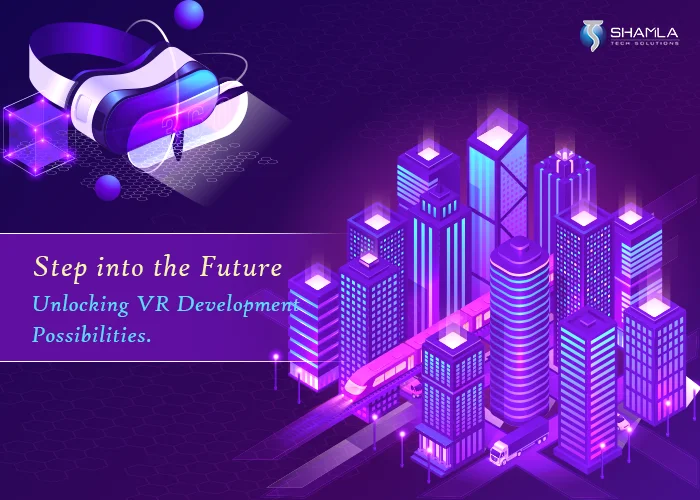
Developers utilise VR software development as a tool to create, develop, and implement simulated, immersive 3D worlds. A variety of software libraries, programming languages, and integrated development are included in these technologies.
They give developers the ability to modify or construct pre-made three-dimensional environments and models in a way that best suits their intended target audience. Furthermore, it enables them to incorporate a range of additional engaging and interactive elements to improve the entire virtual reality experience.
Unity: One of the best VR creation tools is Unity, which is particularly popular for creating challenging games like Pokemon Go and many others. With the help of this cross-platform technology, VR content can be produced that works on a variety of platforms, including PC, console, mobile, and web.
Developers are able to design sophisticated VR system apps that work with various VR headsets by utilizing high-fidelity visuals. VR headsets like the Oculus Rift and HTC Vive, as well as head-mounted displays, are supported by this game engine. A variety of assets and plugins are available for Unity, including the SteamVR plugin, which supports the platform and aids creators in improving the entire VR experience for users.
Blender: Many people use Blender, a free and open-source 3D software suite, to construct powerful virtual reality applications. It includes Blender 2.80, the most recent version, which has been enhanced with quality-level features to make it incredibly user-friendly.
With the use of this software package, developers may produce strong virtual reality applications, high-quality animation content, and visual effects.
This programming tool offers a variety of capabilities, including motion graphics and 3D modeling, and comes with an integrated support system that works with a variety of platforms and devices. Its great versatility and support for a wide range of file formats make it simple for developers to import and export models.
Blender is the finest software development tool for hiring game developers to create your VR application because it has built-in support for Oculus and SteamVR, making it simple for them to test and export. For developers who are new to VR development or need assistance with particular tasks, this can be a wonderful resource.
Maya: A professional tool for creating 3D models and animation is the Maya software. Additionally, it can be utilized to create virtual reality (VR) experiences.
Autodesk’s Maya 3D animation software may be used to create models, animations, and environments. In order to create realistic animations and special effects for its virtual reality experiences, this application allows for the dynamic modification and development of 3D models.
With the VR toolset that comes with Maya, developers can test and produce VR content, including VR cameras and VR animation. Although this software is a professional tool that is frequently used in the business, its capabilities and user interface may seem complicated to a novice user. But for experts in the film and gaming industries, it provides an excellent degree of control and precision.
Unreal Engine: Epic Games is a developer of the Unreal Engine game engine. It is an effective tool for producing interactive 3D material, such as movies, games, and simulations.
The primary users of Unreal Engine include video game makers, movie studios, and businesses that provide architectural visualizations. There is a paid, professional version of the engine in addition to a free, open-source version.
In order to facilitate the creation of incredibly lifelike virtual reality applications, it provides a wide range of tools and dynamic features, including an integrated physics engine and a visual scripting system. Additionally, this engine has a robust developer community that contributes to its development and shares resources like tutorials and high-quality sample content to support it broadly.
Using a renderer optimised for real-time performance, Unreal Engine’s real-time rendering capabilities enable the creation of incredibly realistic, detailed settings and characters. One of its main benefits is this.
In addition, Unreal Engine comes with a large selection of tools for making and altering animations in addition to materials and shaders for realistic surface creation. Numerous operating systems are supported, such as Windows, Mac, iOS, Android, and Linux.
Apart from gaming, Unreal Engine has been increasingly popular in recent years, being used in a variety of industries like television and cinema, automotive, and much more. The fact that this engine allows multi-domain interactions makes this clear.
A-Frame: Using the three.js JavaScript library, this open-source web framework creates three-dimensional virtual reality (VR) experiences that can be accessed by web browsers.
Because it enables developers to work on 3D graphics programming using HTML tags and generate robust VR sceneries, it is a beginner-friendly VR development tool. It gives developers a tremendous deal of versatility when creating 2D and 3D scenes, enabling them to create a VR experience that is both realistic and surreal.
A-Frame also provides a number of well-liked VR development tools, such as the A-Frame Inspector, which lets you examine and troubleshoot scenes, and the A-Frame CLI, which enables you to make and share A-Frame projects.
Key challenges in VR development
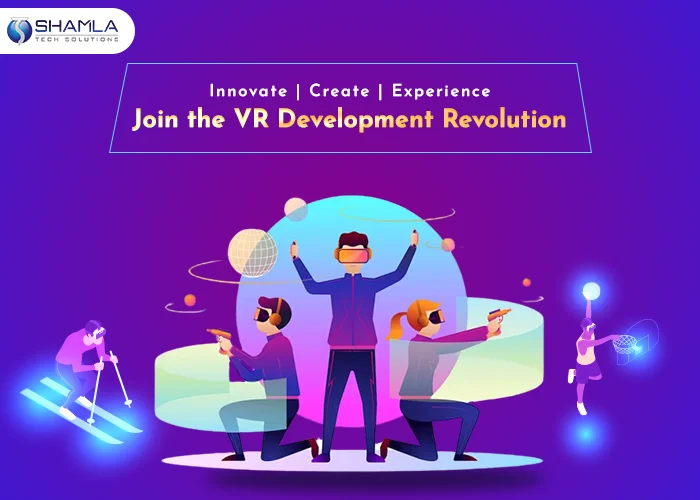
Consumer perceptions: As per the 2022 analysis by ARtillery Intelligence, sixty-one percent of Americans have little inclination towards obtaining a virtual reality headgear. The overwhelming response (63 percent) from those questioned why they aren’t interested in the technology is that they “just aren’t interested.”
VR app demand will decline if consumers in particular show no interest in buying headgear. This can lead to a downturn in the market for VR apps, and it might be harder for developers of these apps to get jobs in the sector.
It is not impossible for one developer or a single night to change how consumers view virtual reality. Customers won’t feel more tempted to utilize virtual reality (VR) for some time, especially as the technology gradually gains traction and new VR applications are released.
Latency issues: Overcoming latency issues is a major problem in the VR market. In essence, latency is the time lag between signals that are sent to and received by the VR gear and software. Consumers desire a flawless experience, yet latency problems detract from the VR user experience.
With the use of mobile edge computing technologies, engineers may be able to solve the latency problem. Virtual reality (VR) is a bandwidth-intensive technology, but mobile edge computing can do more calculations, cut down on latency, and give users a smooth VR experience.
Data privacy and cybersecurity: It’s estimated that concerns about identity theft, fraud, confusion, stolen passwords, location tracking, and data use account for more than half of today’s cell phone users. Developers may find these cybersecurity and data privacy risks difficult to handle. If businesses hope to succeed in the cutthroat VR market and boost app adoption rates, they must incorporate robust security features into their apps.
As developers continue to work on their VR apps, cybersecurity and data privacy will become more and more important. It is imperative for developers to guarantee the safety and security of each user interacting with their virtual reality application. To safeguard their end users, they want to think about implementing the newest cybersecurity techniques and solutions.
Game engine limitations: Since VR software development is still in its infancy, there may be limitations on developer tools. VR app developers can’t employ a flawless software solution to make the perfect VR app.
Unity is a well-liked game engine in the virtual reality field. Online forums like Reddit are a common place for developers and VR aficionados to discuss Unity’s persistent problems. It’s true that these issues with developer tools have the potential to make the development process tedious and time-consuming.
Over time, game engines such as Unity might get better. At the Unity Lab, a specialized research team at Unity works on new projects, develops prototypes, and tests emerging technologies like artificial intelligence.
VR sickness: In the VR community, a new phrase has emerged: VR sickness. In essence, the phrase “VR sickness” refers to the adverse bodily consequences that certain users may encounter when fully submerged in a virtual reality environment. Eye strain, nausea, vertigo, disorientation, and motion sickness are typical symptoms.
Since VR sickness is a relatively new concept, there isn’t a single way for developers to get over this obstacle. Let’s say, nevertheless, that developers are aware of VR sickness and how it affects the VR experience. If so, they can focus on developing immersive experiences that lessen the possibility of VR sickness in users.
To further understand this phenomenon and figure out how to make games that reduce the likelihood of VR sickness, more research is required.
Difference between AR and VR development
- Augmented reality (AR): The ideal fusion of the digital and physical worlds to create an artificial environment is known as augmented reality, or AR. AR-enabled desktop and mobile applications that seamlessly integrate digital elements into the physical world. AR stands for augmented reality in its full form.
For instance, augmented reality technology makes it possible to see score overlays during live sporting events and to see 3D images, emails, and texts.
- Virtual reality(VR): A computer-generated simulation of a different reality or universe is known as virtual reality, or VR. Video games and 3D films both use it. Using computers and sensory apparatus like gloves and headsets, it helps to “immerse” the spectator in realistic-looking simulations.
Virtual reality is utilized not only for games and enjoyment but also for science, education, and training. Virtual reality is VR in its entirety.
How does AR work?
Augmented Reality (AR) employs computer vision, mapping, and depth sensing to present relevant content to users. With the use of this feature, cameras can gather, transmit, and process data in order to display digital material that is relevant to whatever screen a person is viewing.
Real-time contextually relevant digital content is added to the user’s actual environment in augmented reality. Augmented reality (AR) can be experienced using a smartphone or specialized devices.
How does VR work?
Virtual reality is primarily concerned with vision simulation. ShamlaTech is one of the leading VR Development Company in USA. The user must place a virtual reality headset screen in front of their eyes. Consequently, removing all communication with the outside world. Two lenses are positioned between the screen in virtual reality. The user must adjust their eyes according to each eye’s unique movement and placement. An HDMI cable that is connected to a computer or smartphone can be used to render the images on the screen.
uses handheld wearables, speakers, and goggles to mimic a real-world experience. The created world in virtual reality is immersive since it allows for the use of haptic (touch), visual, and audio stimulation.

